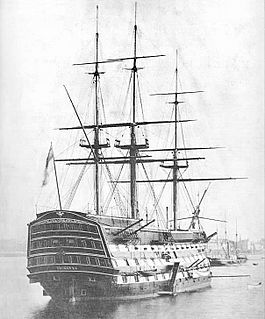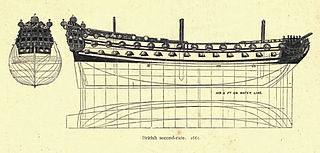 W
WThe rating system of the Royal Navy and its predecessors was used by the Royal Navy between the beginning of the 17th century and the middle of the 19th century to categorise sailing warships, initially classing them according to their assigned complement of men, and later according to the number of their carriage-mounted guns. The rating system of the Royal Navy formally came to an end in the late 19th century by declaration of the Admiralty. The main cause behind this declaration focused on new types of gun, the introduction of steam propulsion and the use of iron and steel armour which made rating ships by the number of guns obsolete.
 W
WIn the rating system of the British Royal Navy used to categorise sailing warships, a first rate was the designation for the largest ships of the line, equivalent to the 'super-dreadnought' of more recent times. Originating in the Jacobean era with the designation of Ships Royal capable of carrying at least 400 men, the size and establishment of first-rates evolved over the following 250 years to eventually denote ships of the line carrying at least 80 guns across three gundecks. By the end of the eighteenth century, a first-rate carried no fewer than 100 guns and more than 850 crew, and had a measurement (burthen) tonnage of some 2,000 tons.
 W
WIn the rating system of the Royal Navy used to categorise sailing warships, a second-rate was a ship of the line which by the start of the 18th century mounted 90 to 98 guns on three gun decks; earlier 17th-century second rates had fewer guns and were originally two-deckers or had only partially armed third gun decks.
 W
WIn the rating system of the Royal Navy, a third rate was a ship of the line which from the 1720s mounted between 64 and 80 guns, typically built with two gun decks. Years of experience proved that the third rate ships embodied the best compromise between sailing ability, firepower, and cost. So, while first-rates and second-rates were both larger and more powerful, the third-rate ships were in a real sense the optimal configuration.
 W
WIn the rating system of the Royal Navy used to categorize sailing warships in the 18th century, a fourth-rate was a ship of the line with 46 to 60 guns mounted. They were phased out of ship of the line service during the French Revolutionary and Napoleonic Wars, as their usefulness was declining; though they were still in service, especially on distant stations such as the East Indies. Fourth-rates took many forms, initially as small two decked warships, later as large frigates razéed from the initial two deck warships, and occasionally even heavily armed merchant ships such as HMS Calcutta.
 W
WIn the rating system of the Royal Navy used to categorise sailing warships, a fifth rate was the second smallest class of warships in a hierarchical system of six "ratings" based on size and firepower.
 W
WIn the rating system of the Royal Navy used to categorise sailing warships, a sixth-rate was the designation for small warships mounting between 20 and 28 carriage-mounted guns on a single deck, sometimes with smaller guns on the upper works and sometimes without. It thus encompassed ships with up to 30 guns in all. In the first half of the 18th century the main battery guns were 6-pounders, but by mid-century these were supplanted by 9-pounders. 28-gun sixth rates were classed as frigates, those smaller as 'post ships', indicating that they were still commanded by a full ('post') captain, as opposed to sloops of 18 guns and less under commanders.